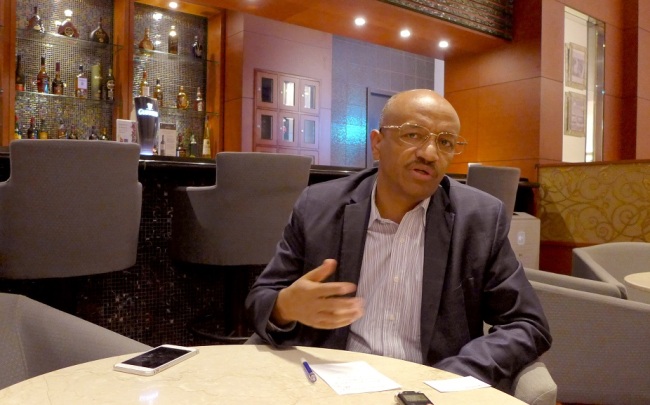A delegation of Ethiopian environment officials came to Korea in early March to share knowledge and experience in forest management and sustainable development.
Shiferaw Teklemariam, Ethiopian minister of environment, forest and climate change, told The Korea Herald that his team was interested in Korea’s policies, institutions and governance, and how they were practically implemented.
Amid Ethiopia’s push to become an industrializing nation, forestry is one of the four pillars of development under the Climate Resilient Green Economy Strategy and the Growth and Transformation Plan.
Shiferaw Teklemariam, Ethiopian minister of environment, forest and climate change, told The Korea Herald that his team was interested in Korea’s policies, institutions and governance, and how they were practically implemented.
Amid Ethiopia’s push to become an industrializing nation, forestry is one of the four pillars of development under the Climate Resilient Green Economy Strategy and the Growth and Transformation Plan.

Through the United Nations Development Program, Ethiopia’s forest sector secured $22 million in institutional and financial support in October last year. This would rehabilitate 330,000 hectares of degraded forest, promote broad-based stakeholder engagement, including with the private sector, and strengthen policy response and innovation.
Through these efforts, the country plans to improve its agricultural productivity and food security, address deficits caused by fuelwood and reduce energy import.
“We wanted to have an in-depth review of how Korea moved very fast in reforesting its once-barren territory in less than 50 years, leading to 64 percent of coverage today,” he said in an interview. “We learned how former President Park Chung-hee and his leadership defined national objectives, mobilized popular support, combined organizations and technologies, and overall, how integration occurred across various sectors.”
During their weeklong tour, the team visited the Korea Forest Service in Daejon, Park Chung-hee School of Policy and Saemaul at Yeungnam University in Gyeongsan City, Erosion Control Memorial Park in Pohang, National Institute of Forest Science in Seoul, Korea National Arboretum in Pocheon, UNDP Seoul Policy Center at Korea University and Global Green Growth Institute in Seoul.
“We discovered how forestation is critically linked to a country’s overall development. As forests grew, Korea’s economic well-being also improved simultaneously,” the minister explained. “There is a direct correlation, as you must develop your water resources, energy infrastructures, income-generating avenues and institutional frameworks. We want to translate these lessons into our own context.”
Forests cover about 15.5 percent of Ethiopia’s territory, mostly in western and southern areas. Teklemariam said that green coverage implicates the distribution of water resources, energy use, economic productivity and food security.
Under the second Growth and Transformation Plan (2016-20), Addis Ababa is working to reforest 1 million hectares of land annually, increasing the coverage to 20 percent by 2020.
Top national concerns include attaining fuel and firewood, mitigating land encroachment, preventing illegal logging and open grazing of unattended livestock, and enhancing management competence and post-plantation oversight.
Several communities in Ethiopia collaborate with Korean agencies, taking inspiration from Korea’s “Saemaul Undong” agricultural movement, which multiplied forest resources 11-fold since 1970 through community mobilization.
In Ethiopia, Teklemariam noted, a similar cause exists, called the “Integrated National Movement,” whereby people are organized into different units and move in unison like a “developmental army” -- to advance agriculture, community development, construction, landscape management, education, health care and natural resource governance.
“What we witnessed from our visit is the systemic administrative backup and technological input into the design, research and development, documentation and follow-up care of forests,” he underlined. “Based on this, we can make improvements and remedy shortcomings.”
Regarding climate change and the United Nations agreement in Paris in last December, Teklemariam indicated that global warming and El Nino adversely affected some 10.2 million Ethiopians as well as compounding drought and flooding.
The government managed to prevent large-scale loss of lives, according to him, but it significantly hit the livestock sector, particularly in northern and central areas.
“If El Nino worsens,” he warned, “it will lead to population migration, livestock losses and political turmoil.”
Teklemariam said the Paris agreement was “a good starting point,” in which 196 governments around the world agreed to limit the rise in global temperature to less than 2 degrees Celsius compared to preindustrial levels, with “efforts” to reduce this down to 1.5 degrees Celsius.
“It is promising as all nations committed themselves to it,” he said. “But agreement is one thing, while implementation is another. There is no international law to enforce the mandate.”
The minister expressed hope in the Grand Ethiopian Renaissance Dam, currently halfway in construction and expected to be completed by 2019, which would generate “green electricity” for the Horn of Africa region.
As part of the African Union’s “Agenda 2063,” which aims for “an integrated, prosperous and peaceful Africa, driven by its own citizens and representing a dynamic force in the global arena” -- the dam would generate some 6,000 megawatts of power with an estimated annual production of 15,700 gigawatts.
“We can reduce about 19 million metric tons of carbon dioxide equivalent from this initiative. We can promote green growth,” he said.
By Joel Lee (joel@heraldcorp.com)
-
Articles by Korea Herald







![[Graphic News] More Koreans say they plan long-distance trips this year](http://res.heraldm.com/phpwas/restmb_idxmake.php?idx=644&simg=/content/image/2024/04/17/20240417050828_0.gif&u=)
![[KH Explains] Hyundai's full hybrid edge to pay off amid slow transition to pure EVs](http://res.heraldm.com/phpwas/restmb_idxmake.php?idx=644&simg=/content/image/2024/04/18/20240418050645_0.jpg&u=20240419100350)






![[From the Scene] Monks, Buddhists hail return of remains of Buddhas](http://res.heraldm.com/phpwas/restmb_idxmake.php?idx=652&simg=/content/image/2024/04/19/20240419050617_0.jpg&u=20240419175937)

![[KH Explains] Hyundai's full hybrid edge to pay off amid slow transition to pure EVs](http://res.heraldm.com/phpwas/restmb_idxmake.php?idx=652&simg=/content/image/2024/04/18/20240418050645_0.jpg&u=20240419100350)

![[Today’s K-pop] Illit drops debut single remix](http://res.heraldm.com/phpwas/restmb_idxmake.php?idx=642&simg=/content/image/2024/04/19/20240419050612_0.jpg&u=)